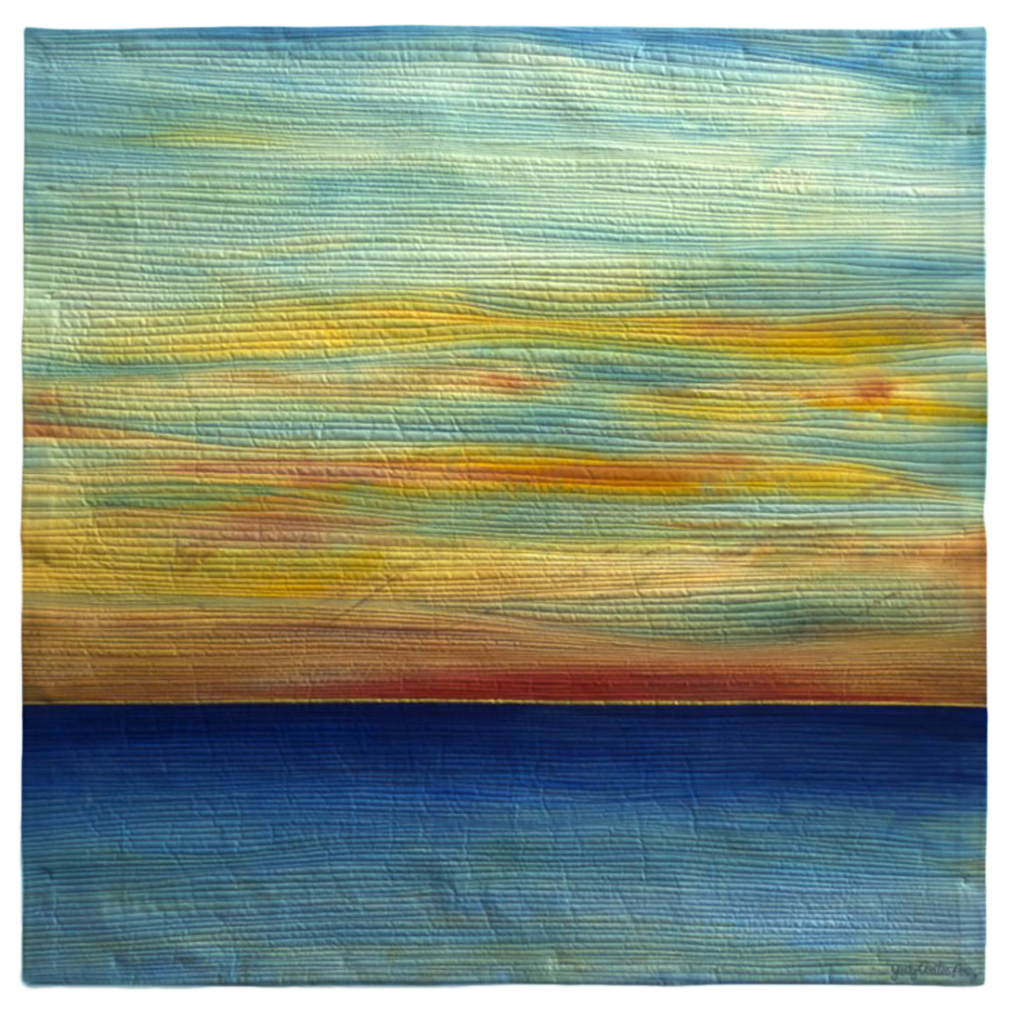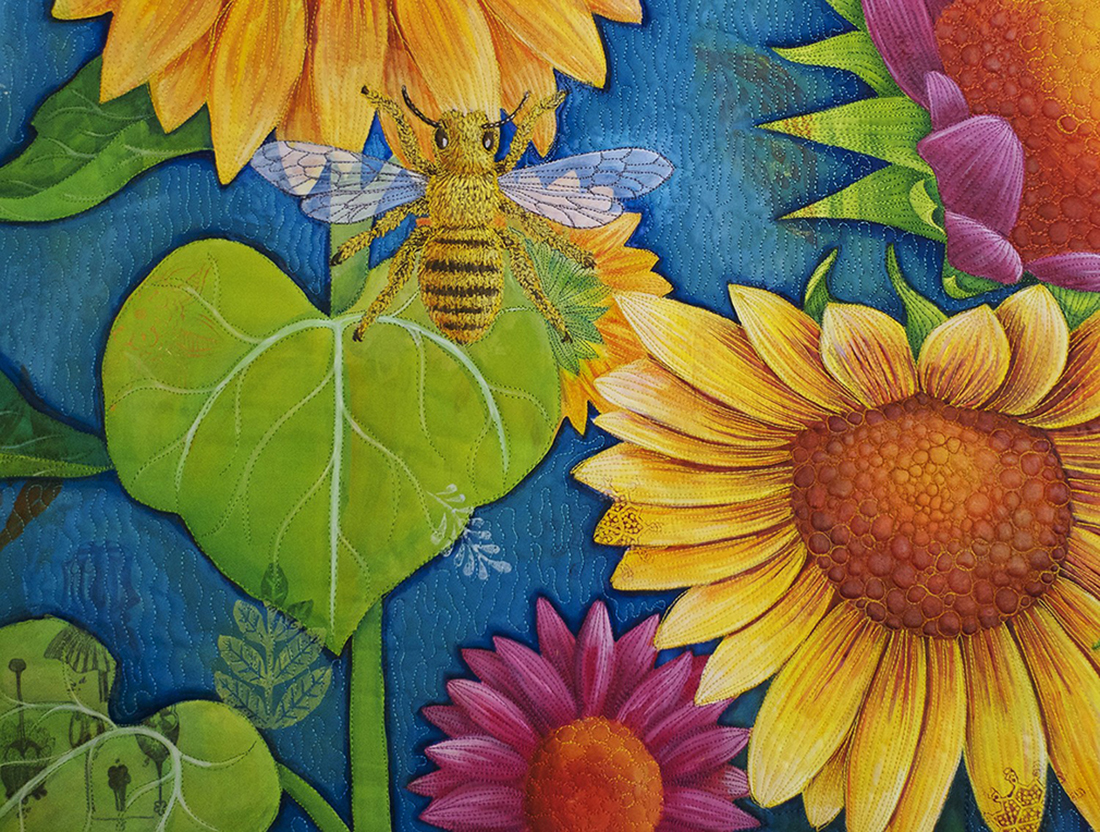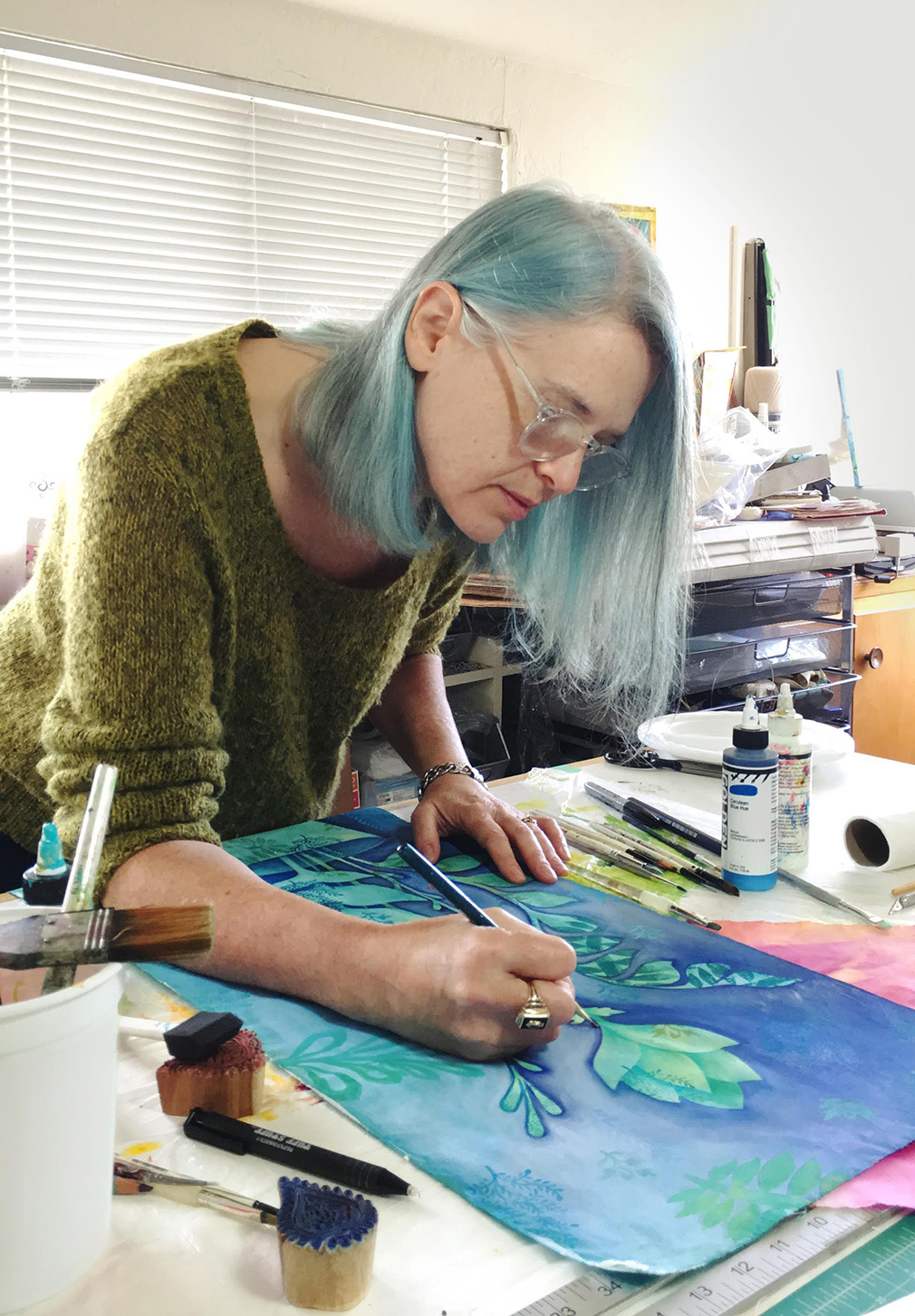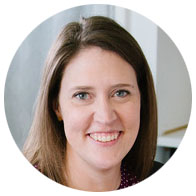
“This photo was taken in New Zealand by one of my students after I taught a class about creating your own printed fabric with acrylic inks and using stamps, thermofax screens as well as patterned fabric created by shibori techniques. I’m holding the pieced quilt that I made from my painted and printed fabric.” This is also Judy Coates Perez’ first pieced quilt in over 20 years.
Photo courtesy of Lynne O’Donnell
Judy Coates Perez is an internationally-recognized, award-winning mixed media textile artist and teacher, and calls the Sacramento, California, area home. Her work is infused with passion, color, and transitions, and reflects the things that are important to her, and the artist herself. As she writes, “My life experiences have always influenced the art; it’s how I tell my story.”
Perez attended the Otis Art Institute of Parsons School of Design in Los Angeles, California, and received her BFA in graphic design, “but found [her] true passion when [she] began working with textiles.” Her passion for art and design is palpable. Judy is a sought-after teacher with a recent solo exhibition and teaching opportunities at the Nadelweldt International Festival for Needleworks in Germany, and upcoming workshops in Wisconsin, Paducah, KY, Craft Napa, and elsewhere in California.
I asked Perez if there was a point in her life where she thought, “Aha! I am an artist.” Many people come to art and making in a rather roundabout way, but that was not her path. She writes:
“I don’t think I was ever aware of a time when I didn’t think of myself as an artist. I think being an artist is when you find ‘flow’ or that moment when time disappears and you are completely lost to the outside world. My first obvious moment of that was when I was in kindergarten and missed the bus home because I was busy drawing a turtle.”
Perez made her first quilts “right out of art school in Los Angeles in ‘85, using solid color cotton fabrics to applique lizards, snakes, and cactus on muslin and using puffy polyester batting. After a couple years of working with store-bought fabrics, I began dye-painting fabric and using textile paints to paint imagery and then appliqued and pieced it together.”

“Crepuscular Flash was made [in 2015] for the Dinner@8 special exhibit Affinity. When I was a teenager I lived in Bodega Bay, California, and I often watched the sun set from the top of a sand dune, and every once in a while, if the conditions were right, you could see a flash of green or gold light as the sun drops below the horizon and momentarily shines through the water. It is painted whole cloth with acrylic inks on cotton fabric and then machine quilted.”
Photo courtesy of Judy Coates Perez
Originally a graphic designer, Perez transitioned to pottery and textile work as she also transitioned into motherhood. She left behind her design clients when she moved to Austin, Texas, in 1995, and did what many artists do when moving to a new city—she looked for a community. When there wasn’t one that precisely met her needs, she started creating a community.
Perez joined the local quilt guild and she “helped start an art quilt group where we challenged each other by creating group quilts with themes based on color theory principles.” It was also during these years in Austin that “she began painting whole cloth with textile paints, did pottery, and started homeschooling.” She found inspiration in her reading, including mythology, science, folklore, and things her children were also interested in.

Judy Coates Perez
Perez also found inspiration in nature—many, if not most, of her recent paintings reflect her love of the natural world. She writes, “I have always been drawn to nature, fascinated by the colors, patterns, and shapes, as well as looking at things from a more biological standpoint.” Her recent paintings are on canvas, not fabric—the canvas uses less paint, allows her to create more imagery, and takes less time than intricate art quilts. Perez recognizes that teaching mixed media painting on canvas may help her workshops reach a broader audience, because “not everyone wants to sit down and sew what they’ve painted, including me sometimes.”
In 2003, she moved back to Los Angeles for two years, and then moved to Chicago. There, she transitioned from homeschooling her kids, to practicing unschooling, which “has the basic theory of letting kids decide what they want to learn and finding ways to make it happen. I never thought of myself as their teacher, but as a facilitator for their education,” which is also how she approaches her popular workshops. They lived in a big loft in downtown Chicago and she included her children in her work. Perez also began to teach locally and nationally during this time. She refers to the loft as an art factory because “ALL the main living areas were set up to work and create. My kids and I often worked side by side.”
Perez is passionate about her work and has created some of her most vibrant pieces during the most intensely challenging parts of her own life, including the end of her time in Chicago.
“[After 7 years in Chicago,] the recession hit, my husband lost his job, then our marriage ended, and we ultimately lost our home and life savings. If I didn’t have art as a way of processing my pain, anger, fear, and frustration during that time I don’t know how I would have survived it. I think I also produced some of my best work that changed significantly from my previous work.
“My earlier work was always created with a plan and painted in an illustrative manner. The work made during my years in Chicago never had a plan. I worked intuitively and emotionally, creating imagery by building up layers of pattern and color using acrylic inks and often writing or drawing on the work with pens and collaging printed imagery in the layers of paint.
“After I was able to do a short sale on the loft and move back to California, and felt some peace in my life, my work started to change again and I began combining elements of both methods of painting in my work.
Now I often have a sense of where I want to take the work with some parts planned and other parts worked more intuitively.”

Detail from “Discovering the Hidden Perks of a Truckload of Dung.”

Perez uses fabric as a canvas—she paints, fuses fabric, incorporates bits of metal, paint pen, and other media into her quilts. When she feels they are sufficiently finished, she then layers the quilt top, batting, and a backing, and quilts the piece. Sometimes, she mixes machine quilting, embroidery, and hand quilting into the same piece.
Photo by Indigo Perez, Judy’s daughter
Perez refers to herself as a creative alchemist, and writes, “An alchemist is a person who purportedly takes base metals and turns them into gold. I see myself as someone who takes everyday objects, like tea bags, printed papers, aluminum, paint, and fabric and combines them creatively to make something of value.”
It is this optimism and passion, as well as the thread of change, transition, and hope that is woven through her vibrant work that I found so inspiring. Her enthusiasm for sharing her work visually through her website and exhibitions, along with her workshops, publications, and her almost too-many-to-count awards, makes this artist a gift to the creative community.
Find Judy Coates Perez Here:
https://www.judycoatesperez.com
https://www.facebook.com/JudyCoatesPerez.TextileArt/
http://instagram.com/judycoatesperez/
Most Recent Book: Make An Impression

Katie Clark Blakesley
contributor
Katie is an author, quilter, and outdoor enthusiast who tries to balance her newfound love of the mountains with everything else. The author of Vintage Quilt Revival and co-founder of Pattern Drop—the only quilt pattern of the month club for creatives who love unique, premium patterns—Katie’s work can most often be found at http://swimbikequilt.com.

I’ve taken several of Judy’s classes (she’s a great teacher!), and have been inspired by her work for a long time. I remember seeing “Primordial Sea” at Houston in 2005 or 2006, and being stopped in my tracks. Thanks for this profile!
Thanks for the great article Katie, and Kristin and Abby for the opportunity to share my work with CIA members, I feel very honored to be featured here. 🙂
What a lovely profile of Judy and her work!
Judy is the most talented artist I have ever had the honor of knowing. Her work is just out of this world, a joy to behold.
Great interview! I absolutely love the photo of Judy holding her pieced quilt- the joy is palpable (and that’s a gorgeous quilt.)